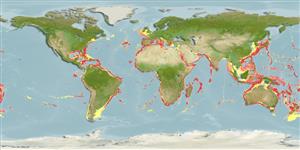|
Decapoda |
Aristeidae
Environment: milieu / climate zone / depth range / distribution range
Ekologi
Bentopelagis; kisaran kedalaman 60 - 1300 m (Ref. 97594), usually 250 - 750 m (Ref. 409). Tropical; ? - 14°C (Ref. 434), preferred 20°C (Ref. 107945); 55°N - 55°S, 180°W - 180°E
Atlantic, the Mediterranean and Indo-Pacific. Tropical to temperate.
Length at first maturity / Size / Weight / umur
Maturity: Lm 3.7, range 3 - 4.414 cm Max length : 17.0 cm TL jantan/; (Ref. 104052); 22.5 cm TL (female); Berat maksimum terpublikasi: 45.90 g (Ref. 126095); Berat maksimum terpublikasi: 45.90 g; Umur maksimum dilaporkan: 8 Tahun (Ref. 80203)
Deep-water benthopelagic shrimp (Ref. 114287). Common total length: 12 to 16 cm. Minimum common depth from Ref. 8. Usually caught on muddy and sandy bottoms of continental slopes (Ref. 434). Lives on bottom mud (Ref. 8); also on sandy bottoms. Moves to midwater at night (Ref. 409). Carnivorous, feeds mainly on euphausiids and other species of crustaceans, i.e., mainly Natantia sp. (Ref. 434). Has a highly diversified diet (Refs. 97770, 105137), preying on pelagic, benthic and benthopelagic organisms (Ref. 105137); mainly forages on crustaceans and fish. Also scavenges upon carcasses of fish and cephalopods on the bottom (Ref. 97770). Exhibits cannibalism. Values of δ15N ranges from 6.68 and 7.96 in females, and 7.05 and 8.26 in males, with females having higher δ15N with increasing size (Ref. 105135).
Spawning occurs during spring to summer. Females have a life span of 7-8 years while males live for 5-6 years.
rujukan utama
Acuan | Koordinator | mitra
Pérez Farfante, I. and B. Kensley. 1997. (Ref. 75620)
Status IUCN Red List (Ref. 130435)
status CITES (Ref. 108899)
Not Evaluated
Not Evaluated
ancaman kepada manusia
penggunaan manusia
Perikanan: komersial
FAO - Perikanan: landings | FishSource | Sea Around Us
Alat, peralatan
Sumber internet
Estimates based on models
Preferred temperature
(Ref.
115969): 5.9 - 15.7, mean 10 (based on 1552 cells).
Daya lenting
Tinggi, Waktu penggandaan populasi minimum kurang dari 15 bulan (K=0.37-0.96; tm=1.5; tmax=8).
Prior r = 0.77, 95% CL = 0.51 - 1.16, Based on 4 full stock assessments.
keancaman
Low vulnerability (10 of 100).
Nutrients: Calcium = 109 [35, 184] mg/100g; Iron = 1.59 [1.21, 1.97] mg/100g; Protein = 20.2 [19.2, 21.3] %; Omega3 = 0.285 [0.185, 0.386] g/100g; Selenium = 48.3 [-31.7, 128.3] μg/100g; VitaminA = 0 μg/100g; Zinc = 1.79 [1.17, 2.40] mg/100g (wet weight).
